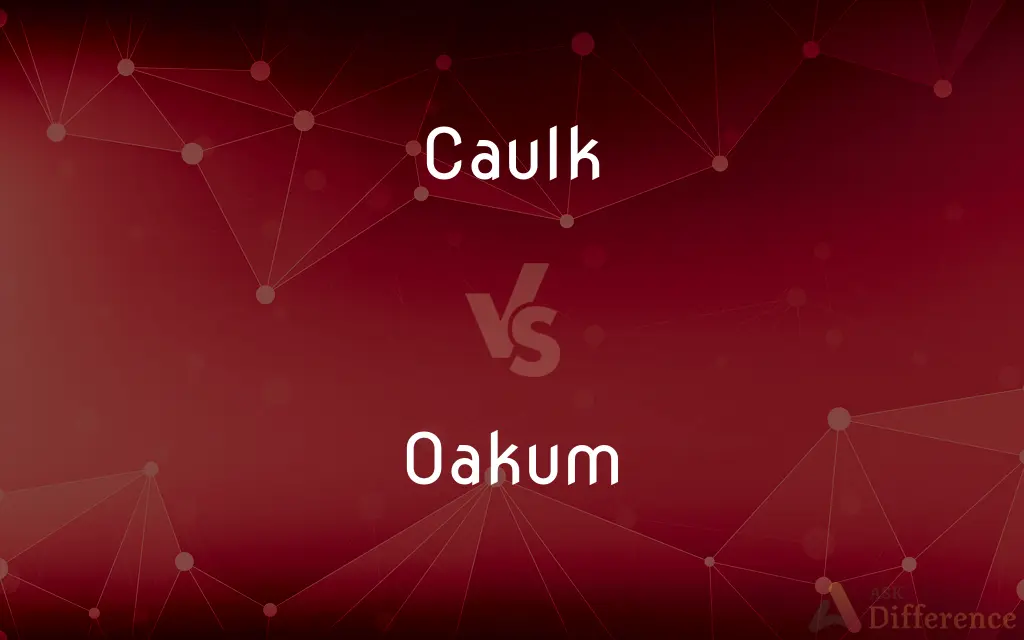Caulk vs. Oakum — What's the Difference?
By Urooj Arif & Fiza Rafique — Updated on April 1, 2024
Caulk is a sealing material used to prevent water and air leaks, while oakum is a fibrous material used for sealing gaps in shipbuilding and plumbing.

Difference Between Caulk and Oakum
Table of Contents
ADVERTISEMENT
Key Differences
Caulk is a flexible, waterproof sealant used in building construction and repairs to fill cracks and joints, ensuring a tight seal against moisture and air. On the other hand, oakum is made from jute fibers or old hemp ropes, traditionally employed in shipbuilding to seal the joints between planks.
The application of caulk is broad, covering areas like windows, doors, and plumbing fixtures to protect against water damage and improve energy efficiency. Whereas oakum is specifically used in situations requiring a sturdy, expandable material to fill large gaps before being sealed with a waterproofing agent.
Caulk comes in various types, including silicone, latex, and acrylic, each designed for different surfaces and conditions, offering flexibility and durability. In contrast, oakum relies on its natural fibrous texture for expansion, making it ideal for sealing irregular spaces tightly once it swells.
The modern usage of caulk has expanded beyond traditional building materials, accommodating a wide range of surfaces like glass, metal, and plastic, due to its adhesive properties. Oakum, however, remains favored in historical ship restoration and traditional plumbing methods for cast iron pipes, preserving its niche application.
While caulk is applied using a caulking gun for a smooth, clean finish, oakum packing requires manual insertion into joints or seams, followed by caulking or hot tar to ensure waterproofing, highlighting the labor-intensive process compared to the more straightforward caulk application.
ADVERTISEMENT
Comparison Chart
Material Composition
Silicone, latex, acrylic, polyurethane
Jute fibers or old hemp ropes
Usage
Sealing joints and cracks in buildings, windows, and doors
Sealing gaps in shipbuilding and plumbing, especially in cast iron pipes
Application Method
Applied with a caulking gun for precision
Manually packed into gaps before being sealed with an agent
Durability
Flexible, durable, and resistant to weather conditions
Swells when wet, enhancing its sealing capability
Main Benefits
Prevents water and air leaks, improves energy efficiency
Effective for large gaps, expands to fill space tightly
Compare with Definitions
Caulk
A material used for sealing air gaps in buildings.
Acrylic caulk was applied to the baseboards for a smooth finish.
Oakum
Absorbs water and swells, improving its sealing ability.
Once wet, the oakum expanded, tightening the gap between the planks.
Caulk
To make watertight by filling or sealing.
Before winter, it's important to caulk windows to prevent drafts.
Oakum
Traditionally used in shipbuilding and plumbing.
Oakum is essential for traditional methods of sealing cast iron pipe joints.
Caulk
Flexible, can be used on a variety of surfaces.
The plumber caulked around the new faucet to ensure a tight seal.
Oakum
Loose fiber obtained by untwisting old rope, used especially in caulking wooden ships.
The restorer packed the wooden ship's seams with oakum before applying pitch.
Caulk
Comes in tubes and requires a caulking gun for application.
We bought several tubes of caulk and a caulking gun for our home renovation project.
Oakum
Derived from natural fibers, making it eco-friendly.
The use of oakum, a natural fiber, adds an eco-friendly aspect to traditional shipbuilding.
Caulk
A waterproof filler and sealant used in building work and repairs.
We used silicone caulk to seal the shower edges against water leaks.
Oakum
Applied by hand and often sealed with tar or cement.
After tamping oakum into the joint, hot tar was poured over to waterproof it.
Caulk
Caulk or (less frequently) caulking is a material used to seal joints or seams against leakage in various structures and piping. The oldest form of caulk consisted of fibrous materials driven into the wedge-shaped seams between boards on wooden boats or ships.
Oakum
Oakum is a preparation of tarred fibre used to seal gaps. Its main traditional applications were in shipbuilding, for caulking or packing the joints of timbers in wooden vessels and the deck planking of iron and steel ships; in plumbing, for sealing joints in cast iron pipe; and in log cabins for chinking.
Caulk
To make watertight or airtight by filling or sealing
Caulk a pipe joint.
Caulked the cracks between the boards with mud.
Oakum
Loose hemp or jute fiber, sometimes treated with tar, creosote, or asphalt, used chiefly for caulking seams in wooden ships and packing pipe joints.
Caulk
(Nautical) To make (a boat) watertight by packing seams with a waterproof material, such as oakum or pitch.
Oakum
A material, consisting of tarred fibres, used to caulk or pack joints in plumbing, masonry, and wooden shipbuilding.
Caulk
To apply caulking
Caulked all around the window frame.
Oakum
The coarse portion separated from flax or hemp in hackling.
Caulk
Caulking.
Oakum
The material obtained by untwisting and picking into loose fiber old hemp ropes; - used for calking the seams of ships, stopping leaks, etc.
Caulk
Caulking.
Oakum
The coarse portion separated from flax or hemp in nackling.
Caulk
A composition of vehicle and pigment used at ambient temperatures for filling/sealing joints or junctures, that remains elastic for an extended period of time after application.
Oakum
Loose hemp or jute fiber obtained by unravelling old ropes; when impregnated with tar it was used to caulk seams and pack joints in wooden ships
Caulk
(nautical) To drive oakum into the seams of a ship's wooden deck or hull to make it watertight.
Caulk
To apply caulking to joints, cracks, or a juncture of different materials.
Caulk
(slang) fuck
Caulk
To fill in the seams or cracks of, with a waterproof material such as caulk.
Caulk
See Calk.
Caulk
A viscous semisolid material of varying composition used to fill in seams of objects which are exposed to water, such as wooden ships or bath tiles; - called also calk and caulking. After applying in a semisolid form, the material hardens and dries to form a waterproof seal. It is used in the process of caulking. It is sometimes applied together with a rope-like cord to fill larger seams.
Caulk
Seal with caulking;
Caulk the window
Common Curiosities
Where is caulk most commonly used?
Caulk is widely used around windows, doors, and other joints in buildings to prevent leaks and drafts.
Is oakum still used today?
Yes, oakum is used in traditional shipbuilding, restoration, and certain plumbing applications, particularly with cast iron pipes.
Can caulk be used for all types of surfaces?
Yes, there are different types of caulk designed for specific surfaces, including glass, metal, and plastic.
What makes caulk durable?
Caulk's durability comes from its flexibility and resistance to weather conditions, making it suitable for both indoor and outdoor use.
What is the primary difference between caulk and oakum?
Caulk is a sealant used for air and water leaks in construction, while oakum is a fibrous material used for sealing gaps in ships and pipes.
How is oakum applied in shipbuilding?
Oakum is packed into the joints between planks on wooden ships before being sealed with pitch or tar.
Why is oakum preferred for sealing large gaps?
Its fibrous nature allows it to expand and fill large gaps tightly, especially when it swells upon getting wet.
How is caulk applied?
Caulk is applied using a caulking, allowing for precise application along seams and joints.
Can oakum be used alone for waterproofing?
No, oakum is typically used in conjunction with a sealing agent like tar or pitch for waterproofing.
How does oakum work?
Oakum expands when it gets wet, enhancing its ability to seal by filling in gaps more effectively.
What type of caulk is most flexible?
Silicone caulk is known for its flexibility and is often used in areas exposed to constant movement or temperature changes.
What are the benefits of using caulk in construction?
It prevents water and air leaks, improves energy efficiency, and can be used on a variety of surfaces.
Is there a difference in the application process between caulk and oakum?
Yes, caulk is applied with a caulking for a smooth finish, whereas oakum is manually packed into spaces before sealing.
Why might someone choose oakum over caulk?
For traditional shipbuilding, historical restoration, or when sealing large, irregular gaps, especially in cast iron piping, oakum's expandable nature makes it the better choice.
How does weather affect the use of caulk and oakum?
Caulk is designed to withstand various weather conditions, while oakum's effectiveness is enhanced by moisture, making it ideal for marine applications.
Share Your Discovery

Previous Comparison
Brotherhood vs. Sisterhood
Next Comparison
Car vs. OarAuthor Spotlight
Written by
Urooj ArifUrooj is a skilled content writer at Ask Difference, known for her exceptional ability to simplify complex topics into engaging and informative content. With a passion for research and a flair for clear, concise writing, she consistently delivers articles that resonate with our diverse audience.
Co-written by
Fiza RafiqueFiza Rafique is a skilled content writer at AskDifference.com, where she meticulously refines and enhances written pieces. Drawing from her vast editorial expertise, Fiza ensures clarity, accuracy, and precision in every article. Passionate about language, she continually seeks to elevate the quality of content for readers worldwide.














































